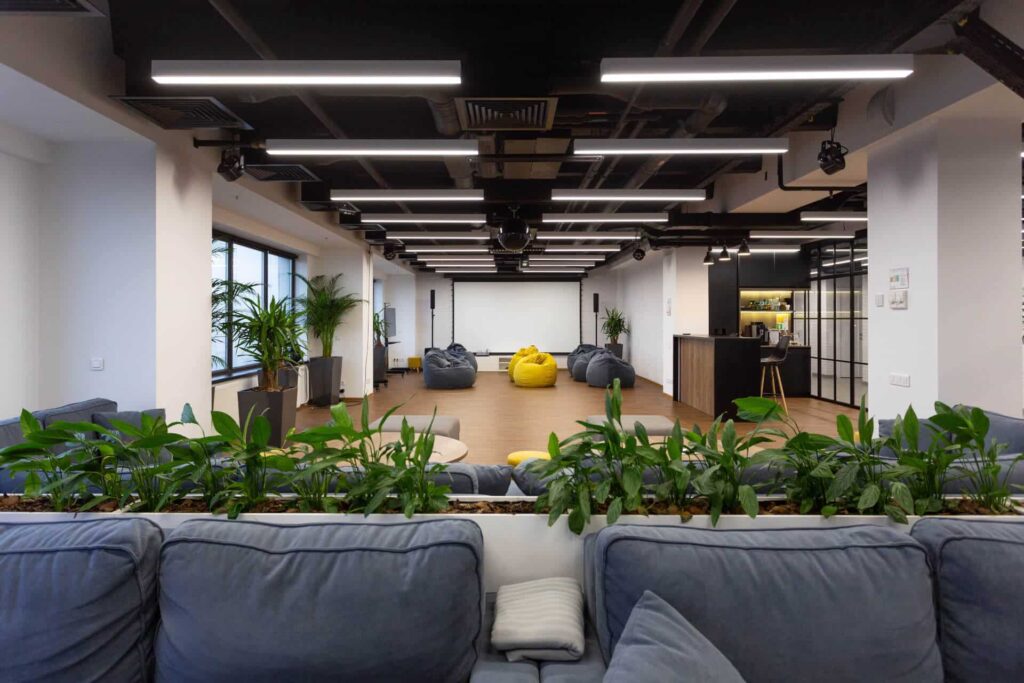Flexible work environments seem to be all the rage these days, with good reason.
Assuming they’re using the right tools and strategies, companies that embrace flexible working can expect to see a variety of benefits, from happier team members to more cost effective real estate portfolios.
In this article, we explore the many benefits of a flexible work environment. We also look at some best practices for creating a more flexible workspace.
What are the benefits of a flexible work environment?
A flexible work environment is any that strays away from the 9-to-5 traditional office. Flexible working can also refer to any number of non-traditional workweeks, such as telecommuting, flextime, or job sharing. And increasingly, when people talk about ‘work flexibility,’ they’re actually talking about the rise in remote and hybrid work.
Ideally, workers will have flexible work arrangements that put them in control over when and where they work. This way, they can create a better work-life balance for themselves. Creating and optimizing a flexible work policy can boost both employee morale and the bottom line. This makes it attractive for both employees and employers, big and small businesses alike.
Of course, flexibility is such a broad term. Benefits will vary from organization to organization, in large part due to which work options companies actually offer to staff.

Four key benefits of the flexible work environment
Companies that embrace a flexible work environment can expect to see a wide variety of benefits in the following four areas.
1. Flexible work environments lead to employee satisfaction
It’s impossible to talk about the benefits of a flexible workspace without first talking about perhaps the biggest stand-out: the positive impact on job satisfaction.
There’s a reason that all generations in the workplace are demanding more flexibility at work. And that companies that offer more remote flexibility can reduce turnover rates by 50%. That’s because workplace flexibility, and especially flexible schedules, is closely linked to more well-being and less stress at work.
Namely, a flexible work environment is closely linked to employee experience. Providing more flexibility and a higher level of autonomy is essential for companies that want their employees to be more engaged and productive.
Work-life balance and the flexible work environment
When implemented correctly, a flexible work schedule makes it much easier for employees to balance their personal life with their work life.
They can schedule their workdays to be working when they’ll be most productive, while also fitting personal priorities in. This can be particularly beneficial for those with families or other caregiver duties.
And given that the average American spends 51 minutes a day commuting, one of the many benefits of working remotely is the opportunity to reduce or evenly completely cut commute times. In fact, employees save an average of $4,000 a year if they switch to remote work. That’s thanks to a reduction in travel costs and expenses. And that’s not to mention how fewer headaches they’ll have in traffic or on packed city buses.
Meanwhile, offering meaningful flexibility is an often sure-fire way to create more empowerment in the workplace. And according to research from the Harvard Business Review, “when employees feel empowered at work, it is associated with stronger job performance, job satisfaction, and commitment to the organization.”
The reality is that most workers want more flexibility, making it critical to staff retention and attraction. Plus, flexibility can open up the talent pool. Especially when companies are willing and able to hire nationally, or even globally.
Ultimately, employees want to stay with a company that respects their wishes, understands they have obligations outside of work, and treats them like adults. This makes creating a more flexible environment one of the keys to happier workers. This in turn can help companies worried about surviving the Great Resignation.
2. Flexible work environments are more cost-effective and productive
Companies can expect many economic benefits to come from adopting flexible working, even beyond improved retention and employee engagement.
Cost savings and the flexible work environment
First, flexible, staggered, and/or hybrid workers use the physical office space much differently. And remote workers won’t use it at all. Headcount planning for a distributed workforce can therefore often lead to companies needing less physical (and costly) office space. And therefore less corporate real estate.
This is especially true when companies also offer flexible seating. Also when they use good workplace analytics to get a better picture of how people are actually using the office.
For example, your occupancy rate often goes down with hybrid work. Assuming facility managers (FMs) are able to track real-time space utilization, they can use this data to make better decisions regarding how much office space they actually need. This can lead to not only a better and more optimized space, but also a smaller—and therefore cheaper—one.
Plus, when you factor in utility savings, as well as the reduced need for office equipment and other services, companies can save around $11,000 for every employee who works remotely just 2.5 days per week.
And of course those savings only go up when they switch from part-time remote to full-time.
Remember, too, that adapting the office to accommodate a more flexible working model can also lead to tech savings on both hardware and software. There are immense benefits of moving to the cloud. Not the least of which is not having to maintain old, standalone systems with back-up drives and documentation.
And an employee going back and forth with a laptop is so much more practical and cost-effective than having to maintain their physical desk.
Productivity and the flexible work environment
Finally, flexible work environments typically lead to more productive workers.
Contrary to widely held but inaccurate beliefs about remote working prior to the pandemic, we now know that remote workers are often more productive than their in-office counterparts. This is not surprising, since flexible workplace models like agile working are expressly for boosting productivity.
Specifically, we know from a Stanford study that workers are 13% more productive when they’re at home.
This is likely due in part to the fact that workers may opt to do their more focus-intensive work at home. They’ll be less distracted, saving the office for collaborative work, learning, and meetings.
Moreover, another large study found that 75% of employees who transitioned to remote work due to the pandemic remained at least as productive as they had been prior.
And in fact, according to Fortune, remote working will lift productivity in the entire U.S. economy by 5%.
Plus, when employees feel empowered, they’re 67% more willing to put in more of an effort. Studies also show more collaboration between employees in flexible work environments.
Given these numbers and how they can benefit the bottom line, it’s not surprising that so many companies are now looking at ways to create more flexible workplace strategies.
3. Flexible work environments are safer
A flexible workplace has the potential to be a much safer one, as well.
Gone are the days of feeling like you have no choice but to come into the office if you’ve only got a slight cough one day, only to end up spreading the flu around.
When human resources makes it clear that employees can and should stay home based on their health (or any recent COVID exposures), then all employees will be healthier. They’ll feel safer, too.
Plus, it’s much easier to maintain social distance in an office that fewer people are using at the same time. Especially when using a tool like Distancing Planner, organizations can easily create a more reassuring space that is much safer and healthier for everyone who uses it.
4. Flexible work environments make it easy to embrace modern ways of working
Flexible work hours aren’t the only type of modern working model workers are now demanding. In fact, most modern work environment types demand some amount of flexibility.
For example, hot desking, in which employees check into desks on a first-come-first-serve basis, only makes sense if employees are using the office on a more ad-hoc basis.
Flexible working also lends itself to office neighborhoods, activity-based working, and all of the four hybrid workplace models. Even those using the ‘traditionalist’ hybrid model, who more or less stick to the 9-to-5 model but use space planning and virtual scenarios to optimize their space, will need flexible ways to maximize their office usage.
Meanwhile, companies using either the architect, nomad, or pioneer models—all of which build-in more remote working in various degrees—require a great deal of flexibility as well as an accompanying flexible work culture.

How do you create a flexible work environment?
A truly flexible work culture is one where employees are more in control of when and where they work. Studies show that it’s when employees have control over flexibility that they enjoy positive health outcomes.
And according to research from Cushman & Wakefield, we also know that employee experience scores jump from 45% to 74% when workers are given complete choice over when and where they work.
So both employees and employers need to ask themselves: What does it mean to be flexible at work? And employees should be given the freedom to create a schedule and environment that works best for them.
Of course, this will likely require collaboration in the workplace between IT, HR, and FM. This way employees can be supported with the policies, tools, and visibility they need to excel wherever they’re working. In particular, every employee will need an easily accessible and well-integrated digital workspace. They also need a visual directory that helps them ‘see’ where their co-workers and any additional resources they may need are on any given day.
Finally, the bread-and-butter of a flexible work environment is good desk booking and room booking systems. When employees come into the physical office, it needs to be easy for them to find and use the workspaces they need.

Why is a flexible working environment important?
Creating a flexible work environment is often the key to improved company culture and more sustainability in the workplace. The future of remote working is one in which more and more employees will want more and more remote and flexible options. Companies that ignore the benefits of flexible work do so at their own peril.
OfficeSpace makes it easy to implement and optimize a variety of flexible work environments. Reach out for a free demo.
Photos: FluxFactory, CoWomen, Petr Magera, .shock




